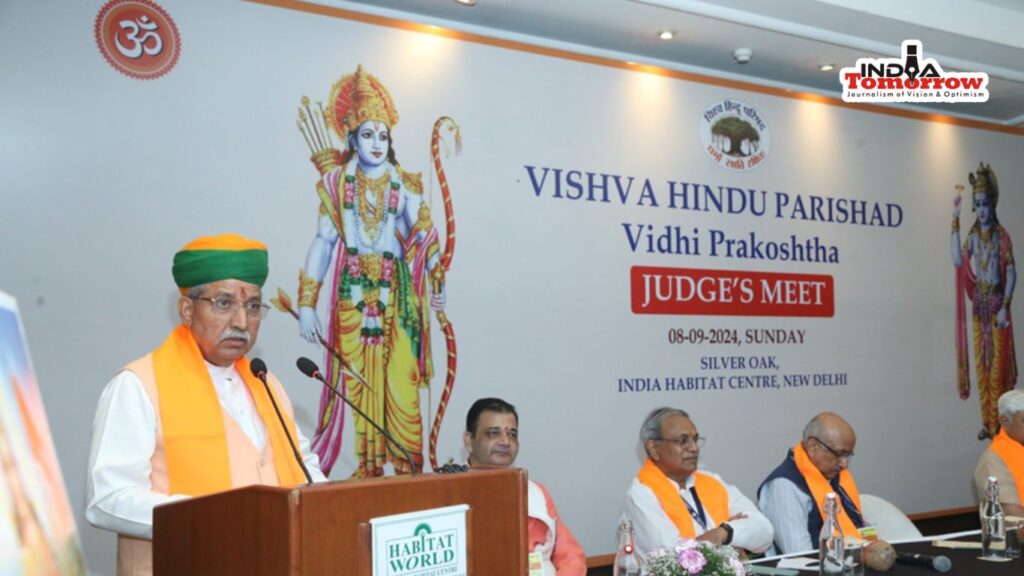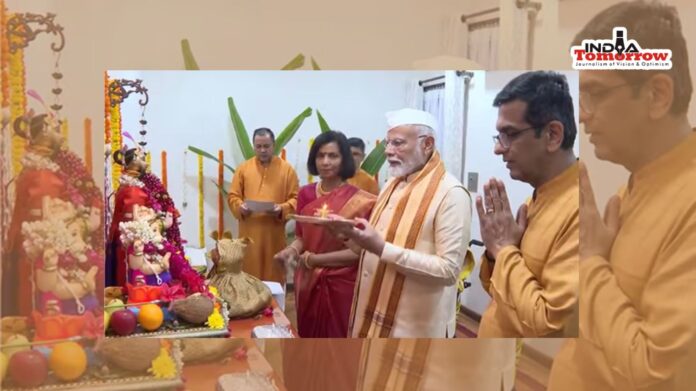By Arshad Shaikh
PUNE–Two events attracted media attention that sparked debate among politicians, intellectual circles, advocates, and academicians, across the nation are the visit of Prime Minister Modi to the residence of Chief Justice D Y Chandrachud to take part in Ganapati Puja and about 30 retired judges of high courts and Supreme Court having attended a Vishwa Hindu Parishad (VHP) function.
While media and senior advocates highly debated PM Modi’s presence at CJI’s residence, the attendance of retired judges did not attract much attention except for routine media coverage. Among the prominent retired judges having attended the VHP programme on September 8 included two former judges of the Supreme Court – Justice Adarsh Kumar Goel and Hemant Gupta.
The attendance of retired judges at the VHP-sponsored event is significant because the VHP function was organized to discuss, among other issues, the religious conversions and the legal battle about the Varanasi and Mathura mosques which are claimed as temples by a section of Hindu radicals. The two mosques currently face litigation from the Hindu parties.

Justice Hemant Gupta, who retired from the Supreme Court in 2022, confirmed his attendance but stated that he did not speak at the event. He emphasized his right as a citizen to attend lawful functions. Justice Goel, who served as chairperson of the National Green Tribunal until last year, also attended. Several legal figures, including Law Minister Arjun Ram Meghwal and VHP President Alok Kumar, attended the meeting.
The two events came under criticism because both the events have the potential to influence the judiciary. While it is well-known that retired judges and Law Minister Arjun Meghwal went to the VHP event as per invitation, it is not clear if the PM visited the CJI’s residence all of a sudden without invitation or if he was invited by the CJI to the puja function at his residence? Who can refuse a guest like PM to attend a puja programme or any religious programme at his/her residence if he expresses his desire even if the protocol (separation of judiciary and executive) does not allow it? Various courts, including the Supreme Court, are hearing various cases involving the government, it would not be morally appropriate for the PM to attend personal functions of the Chief Justice or even other judges because this has the potential to impact public perception of the judiciary. It would certainly send the wrong message to the public as well as judicial circles.
As for former judges attending a function about judicial reforms organized by the VHP is all right, what is objectionable is discussing the legal battle about two mosques claimed as temples by the VHP. It was appropriate neither for the former judges nor the Law minister to have been present there. The law minister should maintain distance from such events. His presence in such programmes has all the possibilities to influence those connected with the delivery of justice in such cases.
It was because of these reasons that political leaders from opposition parties and legal luminaries, including former judges, disapproved of the PM’s presence at CJI’s residence and retired judges and law minister having attended the VHP function that was held to discuss how to organize the legal battle about the mosques in Varanasi and Mathura whom they claim as temples.
While commenting on the PM visiting the CJI’s residence, former Chief Justice of India R M Lodha observed that “There is a constitutional separation of power, and normally, a certain distance is to be maintained between the judiciary and the executive… By such a meeting, public perception of the judiciary gets impacted, but judicial decision-making in a way is not impacted.”

Rajya Sabha MP and Supreme Court Bar Association President Kapil Sibal was more critical in his comments. “I was taken aback by the video… The prime minister of India should never have shown his interest in going to such a private event because… this may send a wrong signal. This is not an opportune time for the Prime Minister to have made a public spectacle of a private ceremony,” he remarked.

Retired Chief Justice of Allahabad High Court Govind Mathur also found fault with the visit to CJI’s residence. “In my opinion, it was not proper to visit CJI’s house,” he remarked but added “I don’t think the visit will influence the CJI’s future judgments, but it will definitely impact his image among the people… It may give the wrong message.”

Shiv Sena (UBT) leader Sanjay Raut questioned, “Sena should question if they will get justice under the CJI in the Sena versus Sena case.” RJD MP Manoj Jha commented, “The Ganpati puja is very personal. You are going there with a camera… The message can be discomforting.”

In a stinging critique on the opinion page of The Indian Express (dated 13 September), senior advocate and legal activist, Indira Jaising, raised serious concerns about the issue. She highlighted the significance of the CJI’s oath to bear “true faith and allegiance to the Constitution” and questioned whether the public display of religious faith breached that oath. She emphasized that secularism is a basic feature of the Constitution, citing the S R Bommai case, where the Supreme Court held that the state “shall not espouse or establish or practise any religion.” According to her, while the CJI and PM are free to exercise their right to religious freedom privately, “the public display of their faith breaches their respective oaths of office.”
Jaising further critiqued the symbolism of the event, noting that this was the first known instance in India’s judicial history where a sitting CJI invited a sitting PM to such a public display of religiosity. She questioned the impact of this on public perception of judicial impartiality, especially as the CJI is set to hear important cases related to Maharashtra’s political landscape. Jaising wrote, “The puja, in public view, by two constitutional functionaries raises the question of whether religion is being infused into the judiciary.”

She also pointed out that this is not the first time the CJI has publicly displayed religious symbols, citing his visit to the Dwarkadhish Temple earlier this year. Jaising raised several questions for the CJI to address, such as why only the Prime Minister was invited and whether other constitutional functionaries were excluded. She also expressed concerns about whether non-Hindu litigants could expect impartial justice after such a display of Hindu rituals and symbols.
In his video vlog on YouTube, former NDTV Editor and author, Ravish Kumar reflects on the deeper implications of Prime Minister Narendra Modi’s visit to Chief Justice DY Chandrachud’s residence, emphasizing the confusion and uncertainty surrounding the event. He noted that while the video was publicly shared by the PM himself, leaving “nothing to hide,” the question remains: “What exactly is there to tell?”
Ravish Kumar quoted journalist Saurav Das who wrote that this incident sends a “dangerous message” to future Chief Justices at all levels of the judiciary. Ravish compared this erosion in the probity of the Indian judiciary to how a river slowly eats away at its banks, suggesting that if the Chief Justice and Prime Minister start meeting at each other’s homes, the separation between the two institutions could collapse entirely.
Ravish underscores how such participation in religious events could erode the separation of powers. He mentions a 2018 incident where Prime Minister Modi visited the Supreme Court and expressed a desire to see Court No. 1, where important cases were being heard against the government, including the Rafale deal. At that time, no one raised questions about the implications of this unprecedented event, just as few have expressed concerns about the Prime Minister’s involvement in Ganapati worship at the Chief Justice’s residence.
Ravish Kumar shifts the focus from the deeper political implications of the PM’s visit to CJI’s house to the technical aspects of how the event was captured on video. Ravish appreciates the meticulous planning behind the video, noting how multiple angles, from the Prime Minister’s arrival to the Chief Justice and his wife welcoming him, were carefully recorded and edited. The attention to detail in capturing this seemingly intimate moment between two of the most powerful figures in India suggests that nothing was accidental; everything was pre-arranged, from the timing to the camera placement, indicating that there was an intended message behind the footage.
However, even as Ravish praises the effort that went into the video’s production, he can’t ignore the underlying question: What exactly was this video trying to convey? While it’s clear that there was nothing hidden, the bigger question of “what was meant to be told” remains unanswered. The answer to that question may well decide the fate of Indian democracy in the years to come.





